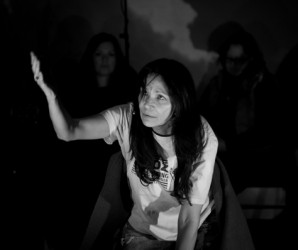Article Origin
Volume
Issue
Year
In the opening scene of Making Treaty 7, Michelle Thrush comes on stage rocking and talking to the imaginary baby she holds in her arms, taking the audience back to a key moment in history: Sept. 21, 1877. Addressing her child, Thrush says, “Today we signed Treaty. We will smoke the pipe. Everything will change. We will no longer have emptiness in our bellies. The buffalo will be protected. Everything is going to change. We will work with the newcomers, share the land, teach our stories and songs. We cannot stop change.”
As the production unfolds, the changes that have taken place over the 137 years following the signing of the treaty are captured in dramatic scenes with the drums of Eya-Hey Nakoda and the music of Kris Demeanor and his Crack Band in the background.
Through the cast of 40 performers, who created their own material, the fallout of the treaty signing is unravelled in dramatic scenes that move backward and forward in time narrated through dialogue, traditional story-telling, song, drums, dance, history and poetry.
Among the themes and issues that emerge are effects of residential schools, decimation of 80 per cent of the Plains people by recurring smallpox epidemics and the deliberate slaughter of 60-70 million buffalo, addiction to colonization, starvation, and bad whiskey.
The idea of the production began with the winding up of Calgary’s year-long celebration as Cultural Capital in 2012, said Michael Green, creative and executive producer. The Aboriginal Advisory Committee wanted to do something bigger and meaningful and so Making Treaty 7 was born.
We wanted something accessible to Aboriginal people with Aboriginal aesthetics integral to programming, says Green.
“Within three months, all Chiefs gave the green light to engage the community of Treaty 7 Elders. Without their direct input, endorsement and support on many levels, sincere community engagement wouldn’t have been possible,” he said.
Of the subtitle, We Are all Treaty People, Green said, “Like people everywhere, Calgarians cultivate their own origin myth. We see ourselves reflected in those myths. Some are not as accurate as they could be. Some elements of origin myths are not serving us well. (First Nations) have been systematically excluded from the happy story which is contemporary Alberta.”
He uses the carrot on the stick analogy to explain. The governments of Canada and the United States made sure there were no buffalo left. “The stick was institutional starvation, the carrot, if you share with us, we’ll take care of you. You won’t be hungry. You will be educated.”
The original spirit and intent of the treaty is resurrected. “The settlers were invited to share the land with people already here,” said Green.
“Our way of learning is storytelling. We come from a long, long line and culture of storytelling,” said Narcisse Blood, an Elder from Treaty 7, who acts as cultural advisor and appears in the production
“I am Nitsipapi,” he said explaining a concept which goes back thousands of years. “In this land, we are humans, our relationship is to what sustains us. What are the consequences when you ignore knowledge that is already here?”
For Blood, the most pressing question that arises is one that Chief Crowfoot asks at the end in an imagined conversation with Col. MacLeod, “Where are we going?”
“What are we doing? What are we doing to our women? What are we doing to the land? What did we do to the buffalo? How can we stop this?” asked Blood.
Making Treaty 7 marks the creation of a new myth that will continue to evolve. “It is a gift to Canada for its 150th birthday in 2017,” said Green.
- 1095 views

